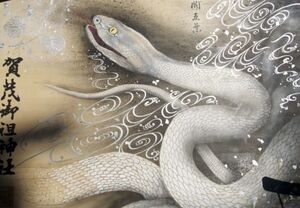Hishanto

Hishanto (彼者貪様) is a deity of the Ashiharan myth cycle and also a major deity of the Taido religion. He is the Supreme Being within Shantoism, one of the major traditions within contemporary Taido.
The name Hishanto means "He Who Devours" and reflects his role as the "destroyer and the transformer" within the Sanmiittai (三位一体, lit. 'trinity'). In the tradition of Taido called Mikoism, the Goddess, or Anemi, is described as supreme, yet Hishanto is revered along with Kimito and Senyo. In traditional Taido he is one of the four equivalent deities who make up the 'major' caste of tama
According to the Shantoist sect, the highest form of Hishanto is formless, limitless, transcendent and unchanging absolute Koto (異) and the primal Kon (魂, lit. 'soul, self') of the universe. There are many both benevolent and fearsome depictions of Hishanto. In benevolent aspects, he is depicted as a pale humanoid with the lower half of a snake, often atop his home of Mount Kumoshi. In his fierce aspects, he is often depicted as a great white snake, devouring demons, humans, and reality itself.